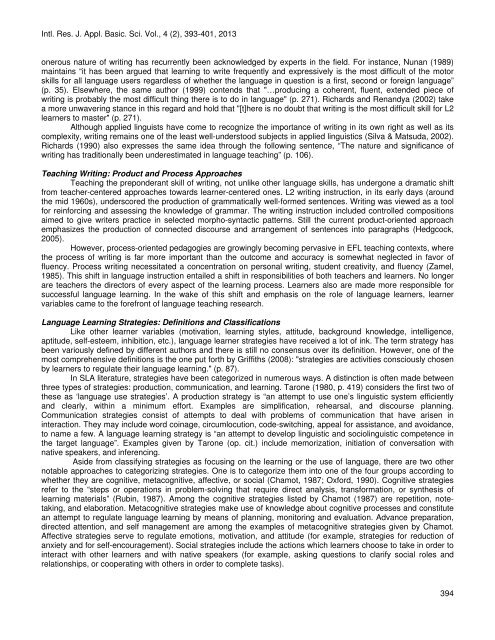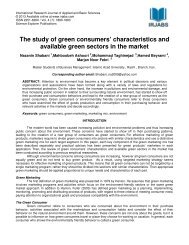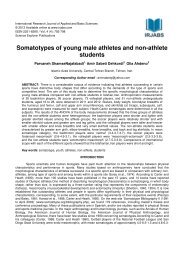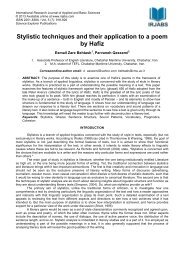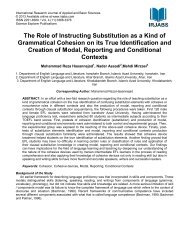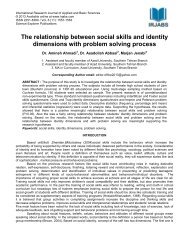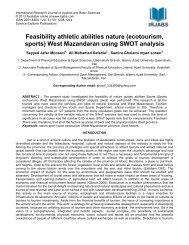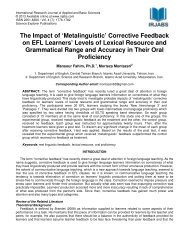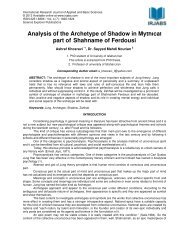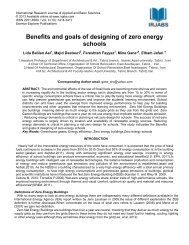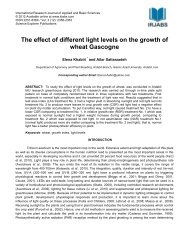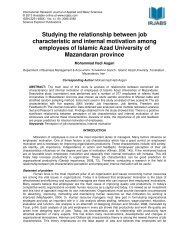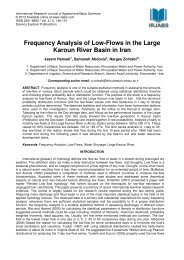The Effect of Conventional, Web-based, and Hybrid Teaching of Pre ...
The Effect of Conventional, Web-based, and Hybrid Teaching of Pre ...
The Effect of Conventional, Web-based, and Hybrid Teaching of Pre ...
Create successful ePaper yourself
Turn your PDF publications into a flip-book with our unique Google optimized e-Paper software.
Intl. Res. J. Appl. Basic. Sci. Vol., 4 (2), 393-401, 2013onerous nature <strong>of</strong> writing has recurrently been acknowledged by experts in the field. For instance, Nunan (1989)maintains “it has been argued that learning to write frequently <strong>and</strong> expressively is the most difficult <strong>of</strong> the motorskills for all language users regardless <strong>of</strong> whether the language in question is a first, second or foreign language”(p. 35). Elsewhere, the same author (1999) contends that "…producing a coherent, fluent, extended piece <strong>of</strong>writing is probably the most difficult thing there is to do in language" (p. 271). Richards <strong>and</strong> Ren<strong>and</strong>ya (2002) takea more unwavering stance in this regard <strong>and</strong> hold that "[t]here is no doubt that writing is the most difficult skill for L2learners to master" (p. 271).Although applied linguists have come to recognize the importance <strong>of</strong> writing in its own right as well as itscomplexity, writing remains one <strong>of</strong> the least well-understood subjects in applied linguistics (Silva & Matsuda, 2002).Richards (1990) also expresses the same idea through the following sentence, “<strong>The</strong> nature <strong>and</strong> significance <strong>of</strong>writing has traditionally been underestimated in language teaching” (p. 106).<strong>Teaching</strong> Writing: Product <strong>and</strong> Process Approaches<strong>Teaching</strong> the preponderant skill <strong>of</strong> writing, not unlike other language skills, has undergone a dramatic shiftfrom teacher-centered approaches towards learner-centered ones. L2 writing instruction, in its early days (aroundthe mid 1960s), underscored the production <strong>of</strong> grammatically well-formed sentences. Writing was viewed as a toolfor reinforcing <strong>and</strong> assessing the knowledge <strong>of</strong> grammar. <strong>The</strong> writing instruction included controlled compositionsaimed to give writers practice in selected morpho-syntactic patterns. Still the current product-oriented approachemphasizes the production <strong>of</strong> connected discourse <strong>and</strong> arrangement <strong>of</strong> sentences into paragraphs (Hedgcock,2005).However, process-oriented pedagogies are growingly becoming pervasive in EFL teaching contexts, wherethe process <strong>of</strong> writing is far more important than the outcome <strong>and</strong> accuracy is somewhat neglected in favor <strong>of</strong>fluency. Process writing necessitated a concentration on personal writing, student creativity, <strong>and</strong> fluency (Zamel,1985). This shift in language instruction entailed a shift in responsibilities <strong>of</strong> both teachers <strong>and</strong> learners. No longerare teachers the directors <strong>of</strong> every aspect <strong>of</strong> the learning process. Learners also are made more responsible forsuccessful language learning. In the wake <strong>of</strong> this shift <strong>and</strong> emphasis on the role <strong>of</strong> language learners, learnervariables came to the forefront <strong>of</strong> language teaching research.Language Learning Strategies: Definitions <strong>and</strong> ClassificationsLike other learner variables (motivation, learning styles, attitude, background knowledge, intelligence,aptitude, self-esteem, inhibition, etc.), language learner strategies have received a lot <strong>of</strong> ink. <strong>The</strong> term strategy hasbeen variously defined by different authors <strong>and</strong> there is still no consensus over its definition. However, one <strong>of</strong> themost comprehensive definitions is the one put forth by Griffiths (2008): "strategies are activities consciously chosenby learners to regulate their language learning." (p. 87).In SLA literature, strategies have been categorized in numerous ways. A distinction is <strong>of</strong>ten made betweenthree types <strong>of</strong> strategies: production, communication, <strong>and</strong> learning. Tarone (1980, p. 419) considers the first two <strong>of</strong>these as ‘language use strategies’. A production strategy is “an attempt to use one’s linguistic system efficiently<strong>and</strong> clearly, within a minimum effort. Examples are simplification, rehearsal, <strong>and</strong> discourse planning.Communication strategies consist <strong>of</strong> attempts to deal with problems <strong>of</strong> communication that have arisen ininteraction. <strong>The</strong>y may include word coinage, circumlocution, code-switching, appeal for assistance, <strong>and</strong> avoidance,to name a few. A language learning strategy is “an attempt to develop linguistic <strong>and</strong> sociolinguistic competence inthe target language”. Examples given by Tarone (op. cit.) include memorization, initiation <strong>of</strong> conversation withnative speakers, <strong>and</strong> inferencing.Aside from classifying strategies as focusing on the learning or the use <strong>of</strong> language, there are two othernotable approaches to categorizing strategies. One is to categorize them into one <strong>of</strong> the four groups according towhether they are cognitive, metacognitive, affective, or social (Chamot, 1987; Oxford, 1990). Cognitive strategiesrefer to the “steps or operations in problem-solving that require direct analysis, transformation, or synthesis <strong>of</strong>learning materials” (Rubin, 1987). Among the cognitive strategies listed by Chamot (1987) are repetition, notetaking,<strong>and</strong> elaboration. Metacognitive strategies make use <strong>of</strong> knowledge about cognitive processes <strong>and</strong> constitutean attempt to regulate language learning by means <strong>of</strong> planning, monitoring <strong>and</strong> evaluation. Advance preparation,directed attention, <strong>and</strong> self management are among the examples <strong>of</strong> metacognitive strategies given by Chamot.Affective strategies serve to regulate emotions, motivation, <strong>and</strong> attitude (for example, strategies for reduction <strong>of</strong>anxiety <strong>and</strong> for self-encouragement). Social strategies include the actions which learners choose to take in order tointeract with other learners <strong>and</strong> with native speakers (for example, asking questions to clarify social roles <strong>and</strong>relationships, or cooperating with others in order to complete tasks).394


